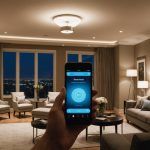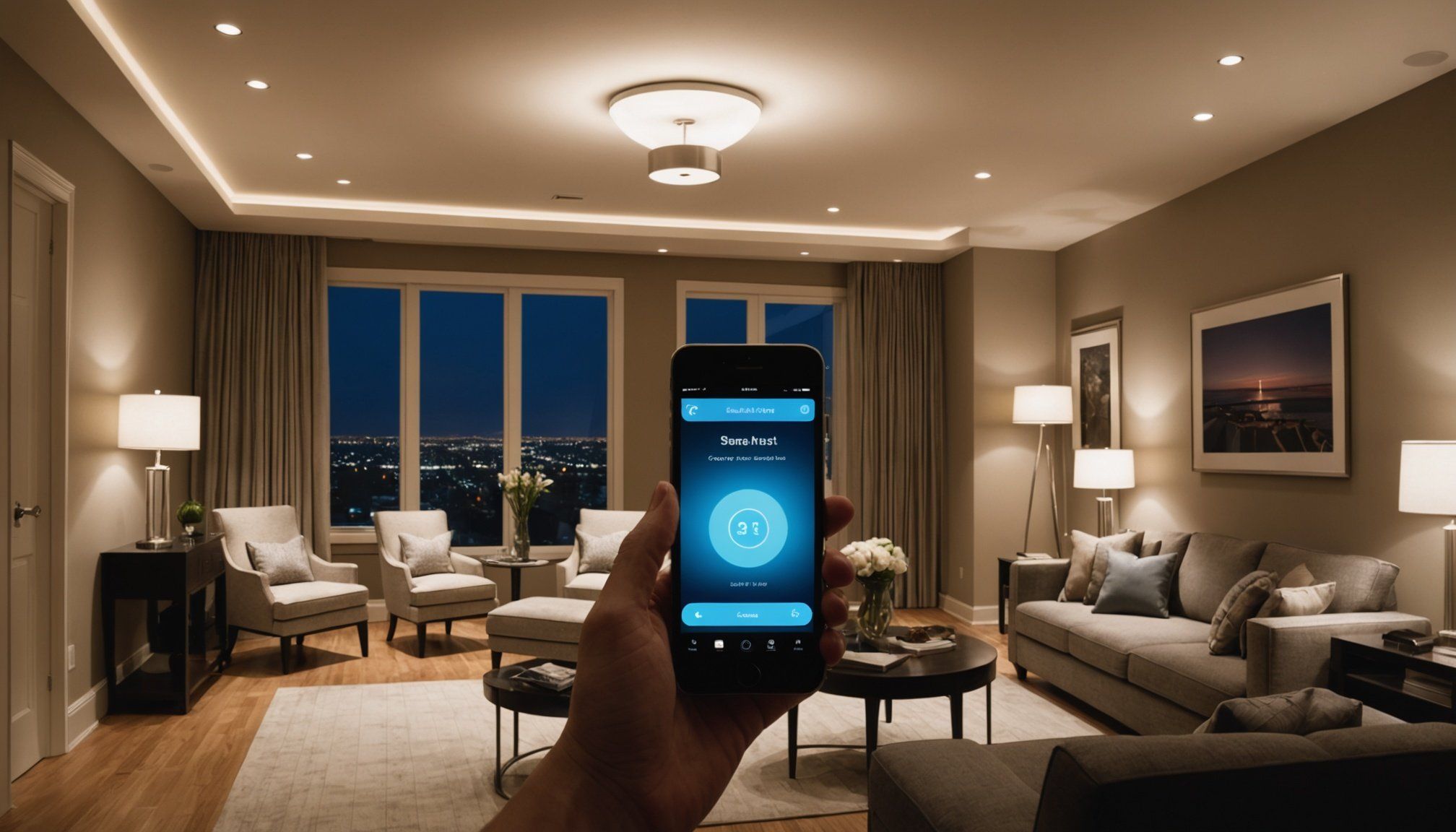Overview of Smart Lighting Systems
Smart lighting systems have transformed traditional home lighting solutions into dynamic and customizable environments. Smart lighting refers to advanced systems that enable users to automate and control lighting fixtures remotely. These systems often integrate with a home’s existing network through technologies such as Wi-Fi, Zigbee, or Bluetooth.
The benefits of smart lighting are manifold, offering enhanced convenience and energy efficiency. Through the use of sensors and timers, smart lighting can automatically adjust to meet the needs of any setting, providing optimal ambience. For example, you can program lights to dim during the evening, reducing energy consumption and creating a relaxing atmosphere.
Also to discover : Revolutionize your grocery experience: utilize ai-powered smartphone tips for smarter shopping!
Wi-Fi-enabled smart lighting allows direct internet connectivity, granting control via smartphone apps from anywhere in the world. Meanwhile, Zigbee lighting systems operate on a dedicated low-power network, ensuring reliable performance with minimal interference. Bluetooth-controlled lights offer a simpler setup, ideal for personal areas where control proximity is limited.
Adopting smart lighting solutions can significantly elevate a home environment. The ability to personalize lighting according to time of day, activity, or mood not only enhances convenience but also positions smart lighting as a pioneering option in home automation experiences.
Additional reading : Transform your smart home office: essential tips for streamlined equipment management using your smartphone
Setting Up Your Smart Lighting
Setting up your smart lighting installation might seem daunting at first, but it’s easier than you’d expect with a step-by-step approach. Start by identifying the type of smart bulbs or fixtures you have. Most products come with a straightforward setup guide, guiding you through initial steps.
-
Install the Smart Bulbs: Ensure your existing light fixtures are compatible. Replace old bulbs with your new smart bulbs, making sure they’re securely in place. For smart fixtures, follow the manufacturer’s instructions, which often involve fixture adjustments.
-
Connect to a Smartphone App: Download the relevant app suggested by your smart bulb manufacturer onto your smartphone. The app acts as your smart lighting hub, allowing you to manage every function. Follow the on-screen prompts to align the app with the lighting device using Bluetooth or Wi-Fi.
-
Configure Basic Settings: Within the app, you’ll find options to customise your lighting preferences. These include brightness, colour choices, and schedule configurations. Set your preferences to tailor your home’s ambiance perfectly.
Creating a connected home environment is attainable with a structured method. The combination of smartphone control and an intuitive app interface makes it engaging and reachable. Once set up, the ease of smart lighting can enhance your daily lifestyle.
Controlling Smart Lighting with Your Smartphone
Smart lighting systems offer groundbreaking convenience, and controlling them via a smartphone app is at the forefront of this revolution. Several popular apps such as Philips Hue, LIFX, and Wyze offer advanced features for managing your home’s ambiance.
These apps make it straightforward to create lighting schedules, allowing you to program lights to automatically adjust at various times of the day. Want your lights to dim in the evening or turn off when you leave for work? These schedules cater to such routines effortlessly and help in energy conservation.
Perhaps the most enticing feature is remote access. Away from home but need to switch on the lights for security purposes? The smartphone app enables remote operations from any location, offering peace of mind. This functionality is not only useful for on-the-go convenience but also heightens home security by giving the illusion of an occupied home.
Smartphone app control, accessible lighting schedules, and the peace of mind brought by remote access features combine to create an intuitive and safe home environment. With technology so readily accessible, the ease of managing your home lighting is quite literally at your fingertips.
Comparing Popular Smart Lighting Products
Exploring the myriad options of smart lighting can be overwhelming, especially when considering the array of smart bulbs available. These bulbs are perfect for those seeking a convenient way to enhance their home’s ambiance. The product comparison showcases several leading smart bulbs known for their energy efficiency, broad compatibility with voice assistants, and user-friendly apps.
Top Smart Bulb Options
The best smart bulbs are often evaluated based on features such as color range, dimming capabilities, and integration with existing smart home systems. Philips Hue consistently ranks high due to its extensive ecosystem, allowing users to customize lighting across various settings. In contrast, LIFX offers bulbs with vibrant colors and easy integration but can be pricier.
Smart Light Strips vs. Smart Fixtures
When comparing smart light strips and smart fixtures, it’s essential to weigh their benefits and drawbacks. Smart light strips are flexible, easy to install, and perfect for under-cabinet or accent lighting. However, they may lack the brightness of fixtures. On the other hand, smart fixtures often provide more lighting power but can be more challenging to install.
Integrated Smart Lighting Systems
For those looking to adopt a comprehensive solution, integrated smart lighting systems provide seamless control over home lighting. These systems, such as Lutron Caséta, offer integrated dimming, scheduling, and compatibility with various smart home devices, making them a top recommendation for full-home automation seekers.
Optimizing Your Smart Lighting Setup
Enhancing your space through smart lighting involves understanding how different lighting effects can transform a room’s feel. By manipulating color temperature and brightness, you can effortlessly create the desired ambiance. Want a soothing environment? Opt for warm color temperatures coupled with dim lighting to mimic a sunset glow. For morning energy boosts, brighter, cool tones can enhance alertness.
Adjustable lighting serves as a robust tool for ambiance creation. Smart bulbs let you tailor moods to your activities. Hosting a dinner party? Lower the brightness for an intimate setting. Reading or working? Increase it to promote focus. The convenience and versatility of these solutions cannot be overstated.
Energy efficiency is another advantage of smart lighting. Energy-saving techniques include utilizing scheduling features to turn lights off automatically when not in use. Incorporate sensors to enable lights only when your presence is detected. This not only reduces energy consumption but also extends bulb life, offering cost savings and environmental benefits.
Smart lighting offers substantial benefits when used correctly. By leveraging its features, you can improve home aesthetics, save energy, and better align your lighting with your lifestyle needs.
Troubleshooting Common Smart Lighting Issues
When it comes to troubleshooting smart lighting, connectivity often tops the list of common problems. If your system seems to be off, verify that your Wi-Fi is stable and that the smart lights are within range. Restarting your router can be a quick fix for many connectivity issues.
Another frequent hiccup involves app-related problems. If your smart lighting app crashes or won’t sync, ensure it’s updated. Clearing the app cache or reinstalling it can resolve persistent bugs. Checking your mobile device’s settings might also reveal missing permissions that are necessary for the app to function correctly.
Lights that are unresponsive or malfunctioning can be frustrating. Start by checking the power source and bulbs. If the problem persists, resetting the smart light to its default settings is often recommended. This step usually involves a specific sequence, found in the light’s user guide.
For deeper technical issues, consult online forums or the manufacturer’s support. Practicing these troubleshooting smart lighting steps can save time and keep your environment bright. If all else fails, professional tech support is a valuable final resource.
Integrating Smart Lighting with Home Automation
Smart lighting is a key component of a smart home integration that transforms traditional living spaces into futuristic sanctuaries. By incorporating smart lighting into indoor and outdoor environments, you can connect and control various IoT devices within your home automation ecosystem with seamless ease.
One of the primary benefits of home automation is the cohesive environment it fosters. Smart lighting interacts with other connected devices, such as thermostats, cameras, and voice assistants, to automate daily tasks effectively. Imagine walking in the door and having your lights automatically adjust based on the time of day or your personal preferences. This interaction multiplies when various gadgets join forces under a unified system.
Consider these automated lighting scenarios for enhanced security and convenience:
- Programming lights to mimic your presence by switching on and off at specific intervals while you are away on vacation, deterring potential intruders.
- Activating exterior lights when motion is detected in your driveway, enhancing security measures.
- Coordinating indoor lighting with your preferred music or TV settings, creating the perfect ambiance for movie nights or gatherings.
Embracing smart lighting within home automation provides not just efficiency, but enhanced security and convenience.











